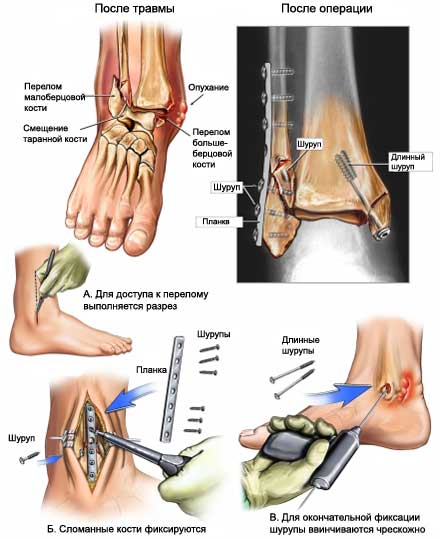Open reduction and internal fixation of bone
Description open reduction and internal fixation of bone
Open reduction and internal fixation (Humanist) It represents operation, which is used for fixing broken bones. Operation is two phases. First, set a broken bone in place. Then the bone is set directly on the device for fixing (Screws, plates, rods, or pins) fracture.
Reasons for open reduction and internal fixation of bone
The operation is performed in the presence of cracks and fractures, that can not be cured by a simple imposition of cast or splint.
Possible complications of open reduction and internal fixation of bone
Complications are rare, but the procedure does not guarantee the absence of risk. If you plan to open reduction and internal fixation of bone, you need to know about possible complications, which may include:
- Infection;
- Bleeding;
- Reaction to anesthesia;
- Blood clots.
Factors, that may increase the risk of complications:
- Smoking;
- Heart or lung disease;
- The history of blood clots;
- Obesity;
- Infection;
- Diabetes.
How is the open reduction and internal fixation of bone?
Preparation for the procedure
- Since fractures caused by trauma or accident, Humanist, usually, It is performed in cases of emergency. Before the operation can be carried out:
- Medical checkup, to check the status of the blood circulation and nerves in the area of broken bones;
- Roentgen, CT scan or MRT – tests, which give an idea of the broken bone and surrounding areas;
- Blood tests;
- Vakcinaciя against stolbnяka – depending on the type of fracture and the presence of grafting, performed earlier;
- Your doctor may ask some questions:
- How do you break the bones?
- How sore fracture?
- Do you take blood-thinning medicines?
- Questions, to Ask the doctor:
- Do I need to undergo rehabilitation after surgery?
- What do I need to assist in recovery (eg, wheelchair, crutches)?
- It is necessary to arrange a ride home after surgery;
- If the operation is an urgent, be sure to tell your doctor and anesthesiologist, when you last ate and drank;
- If the operation is planned, you may be asked to stop taking medications, which thin the blood (warfarin, clopidogrel (Plaviks), aspirin). During emergency surgery, tell your doctor, if you are taking blood thinners or other medications.
Anesthesia
Used general anesthesia, which blocks the pain and the patient support in a sleep state during operation. Introduced in the arm or hand. In some cases, a spinal, or, less often, local anesthesia, just to numb the surgical site. The decision to use a particular type of anesthesia will depend on, where the destruction of the bone and the time, it will take to perform the procedure.
DescriptionMeteoprog proцedurы humanist
Every operation is different from the other Orifov, depending on the location and type of fracture.
First placed in the throat breathing tube, to help you breathe, while you are asleep under the influence of anesthesia. Then the surgeon treats the skin with an antiseptic and makes the cut. Broken bones will be put in place. It then uses the plate with screws, pins, or rod, that hold broken bones together. The incision will be closed with staples or stitches. In place of surgery bandage or plaster.

Srazu posle humanist
After surgery, you will be directed to the recovery room for observation. The breathing tube will be removed. Regularly check the pulse, breathing, blood pressure, and temperature. Also, the pulse will be checked and the condition of the nerves near the broken bone.
How long will open reduction and internal fixation of bone?
ORIF may take several hours, depending on the severity of the fracture.
Open reduction and internal fixation of bone – Will it hurt?
Anesthesia prevents pain during surgery. You will take pain medicine for pain during recovery.
The average time of stay in the hospital after Orifov
This procedure is performed in a hospital. Length of stay will depend on the complexity of the operation and can make 1-7 days.
Care after open reduction and internal fixation of bone
In the hospital
- After surgery, you'll receive nutrition through an IV, until, until they can not eat and drink;
- It is recommended to get out of bed and walk 2-3 once a day, to prevent complications;
- Assigned Physical Therapy. You also need to do the exercises, to regain muscle strength and range of motion;
- It is recommended that frequent cough and breathe deeply, to prevent pneumonia;
- The affected limb will be elevated above the heart, to reduce swelling.
Home Care
When you return home, Follow these steps:, to ensure the normal recovery:
- Change the bandage every day or as directed by a doctor. If the bandage becomes wet or dirty, replace;
- After removing the bandages keep the incision clean and dry:
- Clean the cut with warm water and mild soap;
- Use a soft cloth for cleaning and gentle wipe the incision area;
- Ask the doctor, when it is safe to shower, bathe, or to expose the surgical site to water.
- Check the affected limb sensitivity;
- Get up walking several times a day;
- Keep doing the exercises, prescribed by a physiotherapist;
- Be sure to follow your doctor's instructions.
Contact your doctor after open reduction and internal fixation of bone
After discharge from the hospital need to see a doctor, If the following symptoms:
- Signs of infection, including fever and chills;
- Redness, edema, severe pain in the affected limb;
- Bleeding or discharge from the incision;
- Loss of sensation in the affected limb;
- Swelling or pain in the muscles around the broken bone;
- Pain, which does not pass after taking pain medication appointed;
- Constant urge to urinate;
- Pain or burning during urination;
- Blood in the urine;
- Cough, shortness of breath or chest pain;
- Joint pain, fatigue, constraint, rash or other symptoms.
